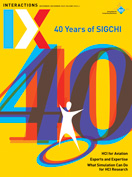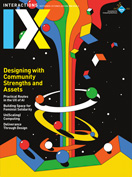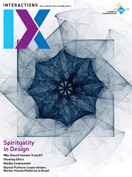Authors:
Pat Vera
Our bodies and geographies of selves made up of diverse, bordering and overlapping "countries." We are all composed of information, billions of bits of cultural knowledge superimposing many categories of communication. —Gloria Anzaldúa [2]
Being in the borders, migrating from the soil that held us captive as bastards of a colonial memory, intersects with the notion of our mestizaje [3] as a contraption, an imperfect and unique machine that reinvents itself in thousands of identity webs. We are "uno," that is, multiple; we carry with us our ancestors, our soil, and the unforgotten history of our Indigenous identity.
In my research, I study our intersections (borderlands) in this vast sea of connections. A rhizomatic web that exposes our inner selves to the complexity of our different identities but that also gives us the space to build community, to coexist, and to cocreate.
I define borderlands [4] as cultural borders, the intersectional [5] margins of class, race, gender, and sexual identity that delimit us as "the other" in the Global North. These borderlands define who I am: Latinx, queer, mestiza, brown, woman. When we see ourselves represented, we claim our identity.
When we see the endless whiteness of the Global North, we hide our souls in the margins; we merge, we don't contest; we colonize ourselves over and over again. Borderlands as physical margins are limits of soil and material distance.
Borderlands as intersectional margins are borderlines that are marked in our souls as carved wounds defined by a culture that we abide by or not. When we recognize ourselves within our identities, we are cultured; we build community; we start "worlding-with." We create that new world that Gloria Anzaldúa reveals as a new "value system that connect us to each other and to the planet" [2].
Paula Moya's essay "Who We Are and from Where We Speak," referencing Latin American decolonial theorist Enrique Dussel's arguments in his book Philosophy of Liberation, reflects on identity and points out that "the political and epistemic significance of different kinds of identities matters for the kind of knowledge we produce." For me, this means that who we are, and the recognition of our own histories, define how we make and exist in the world.
As key vehicle for my research, I developed a land-based methodology in design and pedagogy that I define as land-bordering, which captures the transmission of memories and lived experiences as they connect to the land and the intersections (borderlands) that influenced those experiences. It is making with the land that allows a space of sympoiesis [6] and possibilities. Utilizing land-bordering, I propose a design process of dismantling the colonial structures and concepts of modernity in the design field and its exaltation of the individual and the universal, by looking back, rereading a place and its history, recognizing its Indigenous sovereignty, and bringing in our own original epistemologies from the Global South and the Global North.
 |
Images from Pat Vera's Rhizomatic Maps 2021-2022. |
Land-bordering is a methodology that sits on an onto-epistemic framework. It explores how to restore Indigenous epistemologies toward the creation of a necessary ontological shift, connecting it to the axiology of place, which speaks to the set of values that we bring into our relationships with others and with the land/our planet in its vast but fragile singleness. Our planet is "one big island," a unique ecosystem that works as a large planetary infrastructure that needs each of its parts to sustain its existence. Land-bordering proposes this onto-epistemic framework within a design praxis. It is working toward the engagement of design strategies that can reflect and promote existing Indigenous ways of knowing and doing those present communal practices and technologies that already manifested in an equitable and sustainable relationship to the earth. Embracing these alternative cosmologies to create in design means something different. It means heterogeneity. It means an effort within community.
I designed the Rhizomatic Maps (above), conveying the concept of land-bordering. These maps emerge from themselves in a space of introspection but also of diversion from the canons that perform in traditional mapping. They speak from my own epistemological embodiment of the lands that I lived, and I live on. They are a testimony of histories that are said with my voice, amplifying the voices of others. I am an interlocutor of these stories of migration, of diasporic reflections on identity, place, and sustainment. I am sometimes a wayfinder, a messenger, sometimes just a designer of pathways. The maps travel through the borderlands, arriving and departing but connecting every time. They want to build geographies of selves that can reconnect our social and natural ecologies.
Design practice is intertwined with the political, social, and cultural reality of our societies, where colonialism prevails as the status quo. Bringing in alternative Indigenous technologies opens possibilities to build a design practice that can sustain reconciliation and the emergence of sustainable futures departing from the largely unacknowledged manipulation of our societies created by the current neoliberal, hypercapitalist system that is destroying our planet.
I acknowledge the immense unlearning that implies delinking from colonial and modernist structures in design. The inequalities that we live—racism, discrimination, displacement, violence—put people in the margins through design. Therefore, we need to unlearn the modern colonial canons and un-design our colonial practices. To do that, we must recognize that our world sits in the multiplicity of cosmologies that have been supporting it for millennia. It is through our connections, the rhizom-ing of our diversity and the dialogues that we partake in, that we can find emergences and possibilities through existing original technologies. It is about building relational accountability and shifting the way that we do things in design.
1. "We talk about land" in Indigenous Paraguayan Guaraní language.
2. Anzaldúa, G. Light in the Dark/Luz en lo Oscuro: Rewriting Identity, Spirituality, Reality. Duke Univ. Press, 2015.
3. Mestizaje is a Spanish word that means mixed race. In my case, Paraguayan Guaraní Indigenous ancestry and Spanish-Italian European ancestry.
4. I presented this definition of borderlands in a paper titled "Between Borderlands and Intersections: Roñe'e Yvype (We talk about land)," published by the Design Research Society. DOI: 10.21606/pluriversal.2021.0042
5. Intersectionality is a term coined by Afro-American scholar Kimberlé Crenshaw in 1989. She defines intersectionality as the overlap of social and political identities—race, class, gender, and others—creating different types of discrimination and privilege. In the Latinx diaspora, these intersections, which I redefine as borderlands, also intersect with place, becoming physical borders that respond to geopolitical locations of immigration and displacement.
6. Sympoiesis is defined by Donna Haraway in her book Staying with the Trouble (2016) as a word that means "making-with." "It is a word proper to complex, dynamic, responsive, situated, historical systems. It is a word for worlding-with, in company. Sympoiesis enfolds autopoiesis and generatively unfurls and extends it."
Pat Vera is a Latinx architect, designer, educator, and researcher. Her practice has a special focus in land-based design, social innovation, and sustainability. Her current research focuses on incorporating Indigenous knowledge and alternative epistemologies into land-based design and pedagogy as a way of building equitable and sustainable futures. She is a sessional (adjunct] professor at Emily Carr University and has a master's degree in interdisciplinary design from ECU. She is currently a design Ph.D. student at Cornell University. [email protected] https://patvera.ca
Copyright held by author
The Digital Library is published by the Association for Computing Machinery. Copyright © 2022 ACM, Inc.






Post Comment
No Comments Found